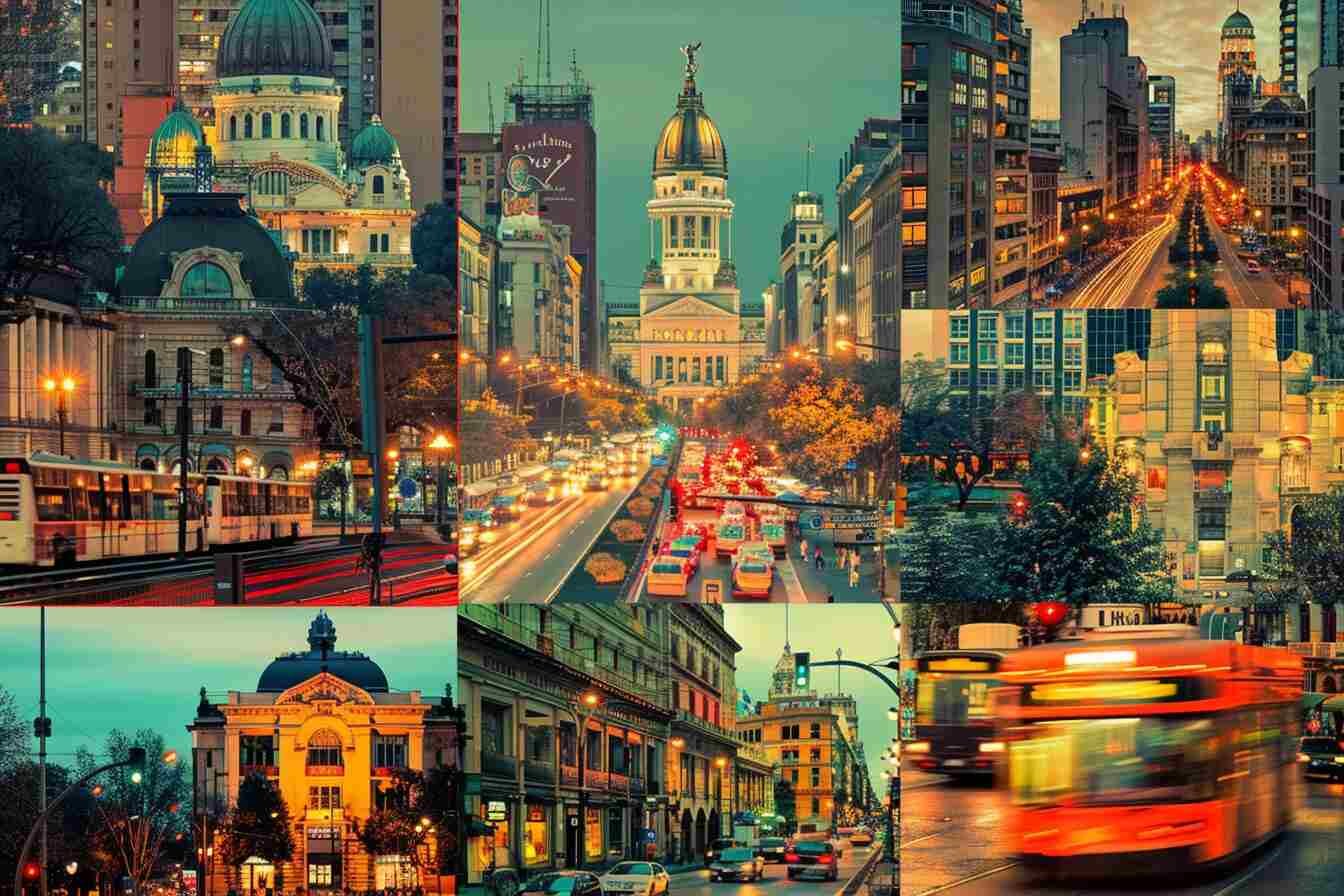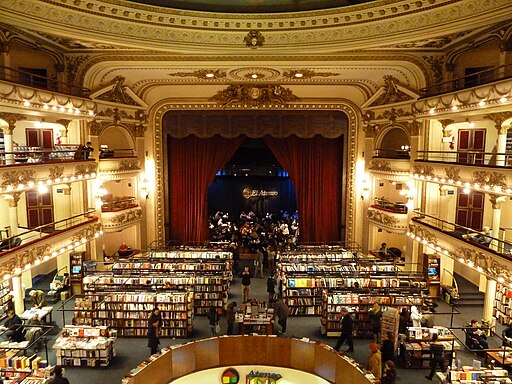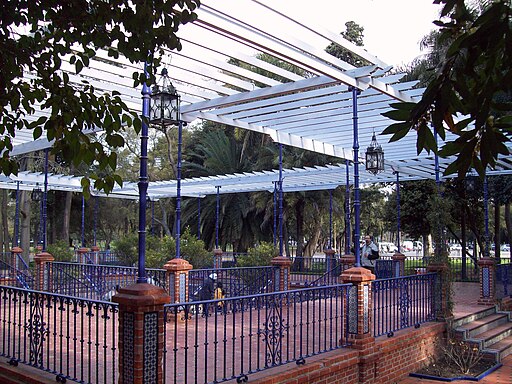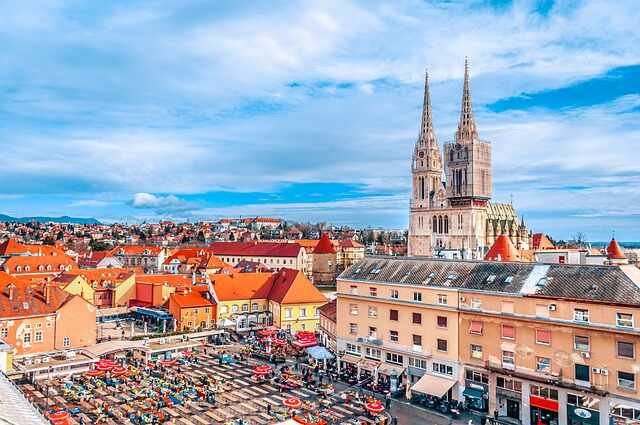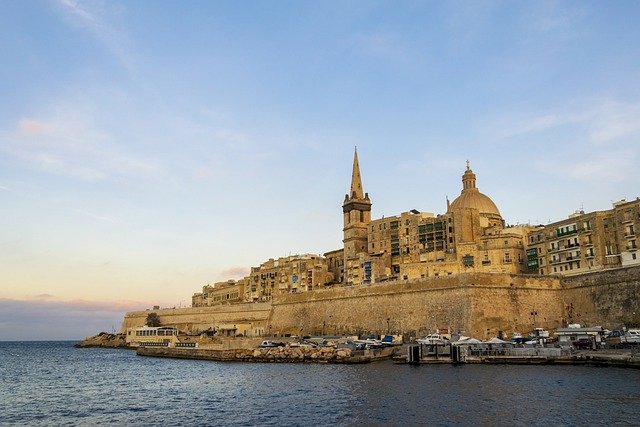Buenos Aires, The Capital City of Argentina
The capital city of Argentina, Buenos Aires, is a dynamic metropolis renowned for its captivating blend of European-style architecture, electrifying tango rhythms, and thriving cultural milieu. Discover below the most iconic and top attractions in Buenos Aires that define the enchanting allure of this capital city of Argentina.
Buenos Aires is a vibrant and cosmopolitan city that attracts millions of tourists each year. The city is known for its rich history, European-style architecture, and lively cultural scene. Visitors can stroll through the colorful streets of La Boca, watch a tango show, or visit one of the many world-class museums, such as the MALBA or the Museo Nacional de Bellas Artes.
Tips:
If you visit Buenos Aires, you can take a city tour and visit some of its famous landmarks such as the Obelisk or the Casa Rosada, the presidential palace. You can also visit the Recoleta Cemetery, where famous figures like Eva Peron are buried. In the evening, you can head to a tango show and watch the passionate dance that originated in Argentina.
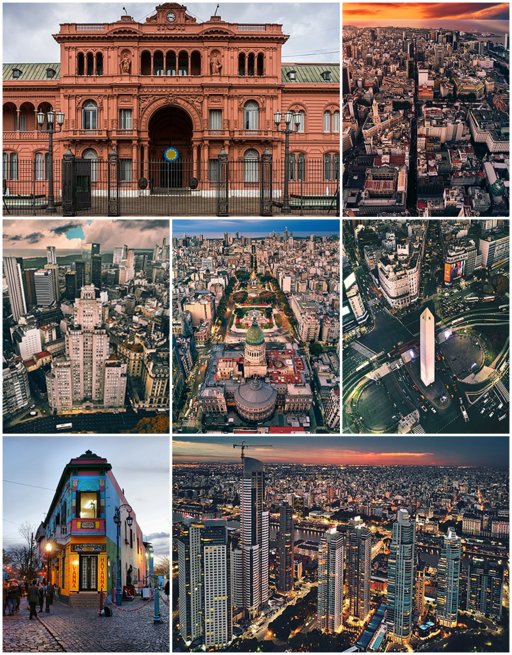
Buenos Aires. From top to bottom and left to right: Casa Rosada, view of the Microcentro, Kavanagh Building, Palace of the Congress of the Argentine Nation and Plaza del Congreso, Obelisk at the intersection of 9 de Julio and Corrientes avenues, the entrance to the Caminito pass in La Boca, Puerto Madero. Bleff, CC BY-SA 3.0, via Wikimedia Commons
Best hotel area to stay for firstimer in Buenos Aires
The best area to stay in Buenos Aires for first-time travelers is the central neighborhood of Recoleta. This upscale district is home to some of the city’s most famous attractions, including the Recoleta Cemetery, the National Museum of Fine Arts, and the famous Floralis Generica sculpture. Recoleta is also known for its elegant architecture, chic cafes, and high-end boutiques. Recommended hotels in Recoleta include the Alvear Palace Hotel and the Palacio Duhau – Park Hyatt Buenos Aires.
Public transport
Buenos Aires boasts a comprehensive and efficient public transportation network that serves as the lifeline of the city. This network facilitates easy and affordable access to various parts of the city and its suburbs, making it one of the most commuter-friendly capitals in South America. Here’s an overview of the main modes of public transportation in Buenos Aires:
1. Subway (Subte)
The Buenos Aires subway, known as “Subte,” is the quickest way to navigate the city. It consists of six lines, labeled A to H, that intersect at various points, making it convenient to transfer from one line to another. The Subte connects major city attractions, commercial areas, and residential neighborhoods.
2. Buses (Colectivos)
Buenos Aires has an extensive bus system with over 150 lines. Buses are frequent and cover more extensive areas than the subway, operating 24/7 on many routes. They are a popular choice for both locals and tourists due to their reach and low cost.
3. Commuter Rail (Trenes)
The city is served by several commuter rail lines that connect Buenos Aires to its suburbs and other cities in the Buenos Aires Province. These trains are essential for daily commuters from the outskirts and are integrated with the Subte and bus lines.
4. Taxis and Ride-Sharing
Taxis are plentiful in Buenos Aires and can be hailed directly from the streets. Ride-sharing services, like Uber and Cabify, are also available and widely used, offering a convenient alternative to public transit.
5. Bicycles (EcoBici)
The EcoBici program offers free bicycles from automated stations scattered throughout the city. This bike-sharing system is a great option for short trips and is increasingly popular for commuting in the city center and along designated bike lanes.
6. Ferries
For those looking to travel between Buenos Aires and cities like Montevideo or Colonia in Uruguay, ferries provide a scenic and efficient mode of transport. The main ferry terminal is located in the Puerto Madero district.
Buenos Aires’ public transportation system is remarkably robust and diverse, providing multiple options that cater to different needs and preferences. Whether by land or water, the city’s transport infrastructure supports an active and bustling urban life.
Top Attractions in Buenos Aires: Exploring the Heart of Argentina
Buenos Aires, the vibrant capital of Argentina, is renowned for its European-style architecture, passionate tango dancing, and rich cultural heritage. Whether you’re a history buff, art enthusiast, or just in search of a lively urban experience, Buenos Aires has something to offer. Here’s a guide to the top attractions in this dynamic city:
1. The Palermo district
Palermo, north of Buenos Aires, is a chic and sprawling neighborhood. It is divided into three parts:
- Alto Palermo, Palermo Chico and Palermo Viejo. Explore its museums, city parks and cobblestone streets.
- Palermo Soho and Palermo Hollywood are lively places with upscale boutiques, cafes and bars.
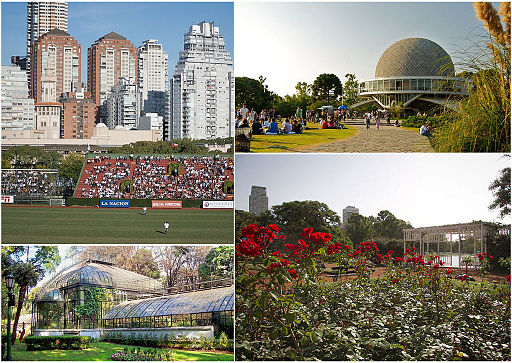
Palermo districs, neighborhood of Buenos Aires. Clockwise from top: the Polo Stadium, the Galileo Galilei planetarium, the Palermo Woods and the Botanical Garden. Bleff, CC BY-SA 3.0, via Wikimedia Commons
For those looking to shop or enjoy the nightlife, Palermo Soho and Hollywood are buzzing with boutiques, bars, and restaurants. By day, the streets are perfect for strolling and café-hopping, while at night, they come alive with some of the city’s best nightlife.
2. Recoleta Cemetery
Located in the prestigious Recoleta neighborhood, this cemetery is not just a burial ground but a true open-air museum. Famous for its elaborate marble mausoleums and the graves of notable Argentine personalities like Eva Perón, Recoleta Cemetery offers a unique insight into the country’s history.
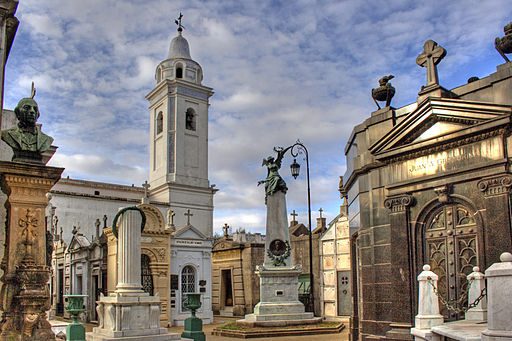
View of the Recoleta Cemetery in Buenos Aires; with obelisk, bust, column and church tower; grave of Juan A Gregorini on the right. HalloweenHJB, CC BY 3.0, via Wikimedia Commons
It constitutes a superb exhibition of funerary architecture from the 19th and early 20th centuries, with family pantheons and vaults of the upper bourgeoisie and former wealthy estate owners.
3. Teatro Colón
One of the most important opera houses in the world, Teatro Colón boasts an impressive architecture and acoustics that are second to none. Guided tours are available to explore the beautiful interiors, or better yet, catch a live performance ranging from opera to ballet.
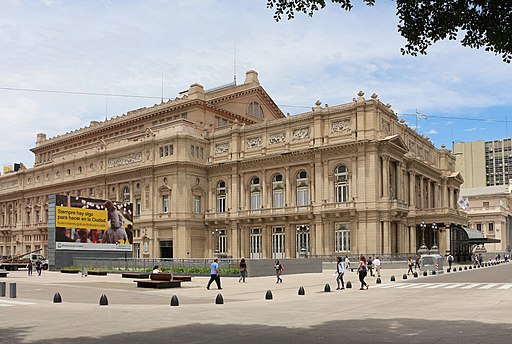
Teatro Colón, Buenos Aires. Bernard Gagnon, CC BY-SA 4.0, via Wikimedia Commons
4. La Boca
Known for its colorful houses and pedestrian street, the Caminito, La Boca is the birthplace of tango. This lively area is filled with artists, tango dancers, and cafes. While touristy, it’s a place where the spirit of old Buenos Aires comes alive.
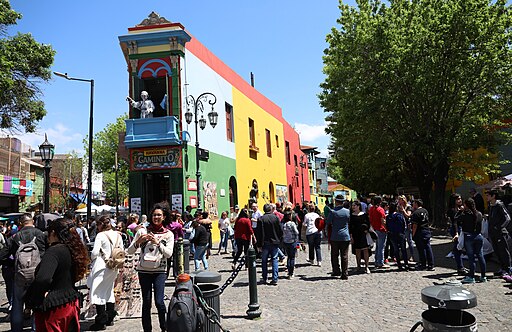
La Boca, Buenos Aires, Argentina. DerHexer, Wikimedia Commons, CC-by-sa 4.0, CC BY-SA 4.0, via Wikimedia Commons
5. San Telmo Market
San Telmo’s Sunday market is the place to find antiques, handicrafts, and curiosities. The neighborhood’s charming old buildings, cobblestone streets, and artists’ studios make it a favorite haunt for locals and tourists alike.

San Telmo Market, Buenos Aires. Andrzej Otrębski, CC BY-SA 4.0, via Wikimedia Commons
6. Puerto Madero
Once a derelict port area, Puerto Madero has been transformed into one of Buenos Aires’ most exclusive districts. This waterfront area features upscale restaurants, chic bars, and the iconic Puente de la Mujer by Santiago Calatrava. It’s also a great place to walk along the docks and enjoy the views.

Puerto Madero montage. Bleff, CC BY-SA 3.0, via Wikimedia Commons
7. Malba (Museo de Arte Latinoamericano de Buenos Aires)
Palermo Chico distric is home to extravagant mansions near the Museum of Latin American Art of Buenos Aires (MALBA).

Malba (Museo de Arte Latinoamericano de Buenos Aires). Danielseo451, CC BY-SA 4.0, via Wikimedia Commons
This museum is home to one of the most significant collections of Latin American art, Malba exhibits works from the early 20th century to the present. The museum is not only a cultural treasure but also a modern architectural gem.

The interior of MALBA in Buenos Aires, Argentina. OneEuropeanHeart, CC BY 3.0, via Wikimedia Commons
8. Plaza de Mayo
As the historical and political heart of Buenos Aires, Plaza de Mayo is surrounded by landmarks such as the Casa Rosada, the Cabildo, and the Metropolitan Cathedral. This square is a witness to many of Argentina’s political demonstrations and is a must-visit for those interested in the country’s history.
9. El Ateneo Grand Splendid
Considered one of the most beautiful bookstores in the world, El Ateneo Grand Splendid was once a theater. Today, it retains its splendid frescoed ceilings and ornate carvings, offering a magical environment for book lovers.
El Ateneo Grand Splendid, Buenos Aires. Galio, CC BY-SA 3.0, via Wikimedia Commons
10. Tango Shows
No visit to Buenos Aires would be complete without experiencing the passion of tango. Attend a traditional tango show or dine in one of the city’s tango-themed restaurants. It’s an ideal way to immerse yourself in the local culture and end a perfect day in Buenos Aires.
From its iconic landmarks to its bustling street markets, Buenos Aires invites visitors to delve into a world of cultural richness and spirited traditions. Whether it’s your first visit or a return trip, these top attractions are sure to make your stay unforgettable.
11. Museo Nacional de Bellas Artes
Housing an impressive array of Argentine and international art, the Museo Nacional de Bellas Artes is one of Latin America’s most important art museums. Its collection spans several centuries and includes works by Rembrandt, Goya, and Van Gogh, among others.
Museo Nacional de Bellas Artes in Buenos Aires. Photo taken from the Metalsur Starbus. Lars Curfs, CC BY-SA 3.0 NL, via Wikimedia Commons
12. Fundación Proa
Located in La Boca, Fundación Proa is a contemporary art museum known for its cutting-edge exhibitions and stunning views of the old port. It frequently hosts exhibitions from top global artists and is a must-see for modern art lovers.
13. Feria de Mataderos
Experience the traditional Argentine gaucho culture at the Feria de Mataderos. This fair combines folk music, dance performances, and gaucho skill demonstrations. It’s a fantastic way to see Argentina’s rural traditions alive in the city.
14. Jardín Botánico
Spanning over seven hectares, the Jardín Botánico is a green oasis in the middle of Palermo. It is home to thousands of plant species, several greenhouses, and beautiful sculptures, making it a peaceful retreat from the urban bustle.
15. Museo Evita
Dedicated to the life of Eva Perón, this museum is housed in a lovely restored mansion. It provides a deep dive into Evita’s life through her clothing, photographs, and personal belongings, illustrating her impact on Argentine politics and society.

Museo Evita. Ashanterius, CC BY-SA 3.0, via Wikimedia Commons
16. Parque Tres de Febrero
Also known as Bosques de Palermo, this extensive park features lakes, groves, and rose gardens. It’s perfect for picnics, boating, or just a leisurely stroll. On weekends, it becomes a lively gathering spot for locals.
17. Usina del Arte
A cultural center in a refurbished power plant in La Boca, Usina del Arte hosts concerts, exhibitions, and other cultural events. Its architecture alone is worth the visit, and the variety of performances makes it a cultural hotspot.
18. Café Tortoni
The oldest café in the city, Café Tortoni, is a perfect spot to experience the Belle Époque era of Buenos Aires. Enjoy a coffee or traditional Argentine snacks while soaking up the historic atmosphere and maybe catching a tango show.

Cafe Tortoni, Buenos Aires. Ramon Corvera, CC BY-SA 3.0, via Wikimedia Commons
19. Corrientes Avenue
Known as the street that never sleeps, Corrientes Avenue is bustling with bookstores, theaters, and pizzerias. It’s the best place to experience the city’s vibrant nightlife and catch a performance or just people-watch.
20. Ecological Reserve
Just beyond Puerto Madero, the Ecological Reserve offers a natural escape with walking trails, bird watching, and incredible views of the river. It’s a contrast to the city’s busy streets and a reminder of the area’s natural beauty.
21. Cementerio de la Chacarita
While Recoleta Cemetery gets most of the attention, Cementerio de la Chacarita is where many local celebrities and historical figures are buried. It’s less touristy and equally full of impressive monuments and mausoleums.
22. Museo de Arte Moderno de Buenos Aires (MAMBA)
Located in San Telmo, MAMBA offers an impressive collection of modern and contemporary art from Argentina and beyond. Its dynamic exhibitions and interactive installations make it a favorite for art lovers.

Museo de Arte Moderno de Buenos Aires (MAMBA), Museum of Modern Art building in Buenos Aires. Andrzej Otrębski, CC BY-SA 4.0, via Wikimedia Commons
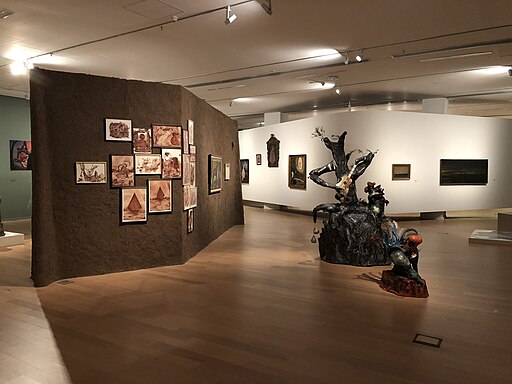
One of the galley rooms in MAMBA. H2moma, CC BY-SA 4.0, via Wikimedia Commons
23. Casa Rosada
The iconic pink presidential palace where the offices of the President of Argentina are located. It’s famous for its balcony, from which Eva Perón addressed throngs of supporters. Guided tours are available, offering a glimpse into Argentina’s political history.
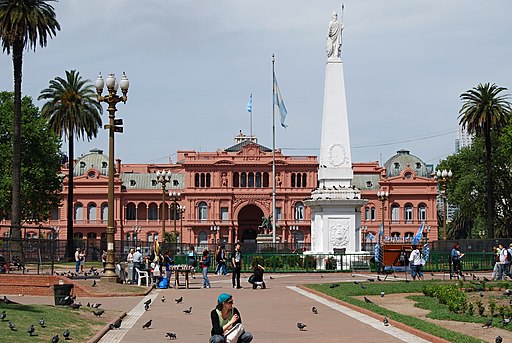
Plaza de Mayo and the magnificent palace Casa Rosada – Buenos Aires. Pavel Špindler, CC BY 3.0, via Wikimedia Commons
24. Congreso Nacional
An architectural marvel, the National Congress building is impressive with its dome and vast array of artistic and historical artifacts inside. Visiting when sessions are open to the public can provide insight into Argentine legislative proceedings.
25. Barrio Chino
Experience a different side of Buenos Aires in its bustling Chinatown. It’s a great place to shop for unique goods and enjoy authentic Asian cuisine. The area is particularly lively during Chinese New Year celebrations.
26. Museo Nacional de Arte Decorativo
Housed in an exquisite neoclassical mansion, this museum showcases a wide range of decorative arts, including furniture, ceramics, and textiles from Europe and Asia. The interior of the mansion is as impressive as the collections it holds.
27. Biblioteca Nacional Mariano Moreno
The national library of Argentina is not only a repository of books but also an architectural landmark. Its modern design and cultural significance make it a must-visit for anyone interested in literature and architecture.
28. El Zanjón de Granados
Explore the fascinating subterranean world of El Zanjón de Granados in San Telmo. This restored residence offers tours through a series of tunnels and cisterns dating back to the 16th century, revealing layers of the city’s history.
29. Paseo del Rosedal
A stunning rose garden in Parque Tres de Febrero, Paseo del Rosedal features over 18,000 roses. It’s a picturesque spot for a leisurely walk or a paddleboat ride on the nearby lake.
Paseo Andaluz in the parks of Palermo, Buenos Aires, view from outside the promenade, on top of a bench. Gelpgim22 (Sergio Panei Pitrau), CC BY 3.0, via Wikimedia Commons
30. Manzana de las Luces
“Block of Enlightenment” is an historically significant block in the city’s oldest area. It includes a series of tunnels, old Jesuit buildings, and cultural spaces that often host exhibitions and performances.
31. Museo del Humor
Celebrating Argentine humor, this museum showcases the work of cartoonists and illustrators from the early 20th century to the present. It’s a light-hearted and insightful look at Argentine culture through satire and comedy.
Each spots in Buenos Aires tells a unique story, painting a fuller picture of a city that’s rich in diversity and culture. Whether you’re exploring the arts, enjoying nature, or uncovering historical secrets, Buenos Aires offers an endless array of experiences for every traveler.
Sources: PinterPandai, Buenos Aires Ciudad, Touropia
Main photo powered by Midjourney
South America Travel Guide 12 Countries and Dependent Territories
